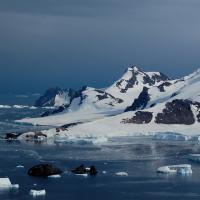Changing Antarctic waters could trigger steep rise in sea levels

The research published in Nature Communications found that in the past, when ocean temperatures around Antarctica became more layered – with a warm layer of water below a cold surface layer – ice sheets and glaciers melted much faster than when the cool and warm layers mixed more easily.
This defined layering of temperatures is exactly what is happening now around the Antarctic.
“The reason for the layering is that global warming in parts of Antarctica is causing land-based ice to melt, adding massive amounts of freshwater to the ocean surface,” said ARC Centre of Excellence for Climate System Science researcher Prof Matthew England an author of the paper.
“At the same time as the surface is cooling, the deeper ocean is warming, which has already accelerated the decline of glaciers on Pine Island and Totten. It appears global warming is replicating conditions that, in the past, triggered significant shifts in the stability of the Antarctic ice sheet.”
The modelling shows the last time this occurred, 14,000 years ago, the Antarctic alone contributed 3-4 metres to global sea levels in just a few centuries.
“Our model simulations provide a new mechanism that reconciles geological evidence of past global sea level rise,” said researcher UNSW ARC Future Fellow Dr Chris Fogwill.
“The results demonstrate that while Antarctic ice sheets are remote, they may play a far bigger role in driving past and importantly future sea level rise than we previously suspected.”
The accelerating melting of land ice into the sea makes the surface of the ocean around Antarctica colder, less salty and more easily frozen, leading to extensive sea ice in some areas. It is one of the reasons ascribed to the increasing trend in sea ice around Antarctica.
To get their results the researchers used sophisticated ice sheet and climate models and verified their results with independent geological observations from the oceans off Antarctica. The geological data clearly showed that when the waters around the Antarctic became more stratified, the ice sheets melted much more quickly.
“The big question is whether the ice sheet will react to these changing ocean conditions as rapidly as it did 14,000 years ago,” said lead author Dr Nick Golledge, a senior research fellow at Victoria’s Antarctic Research Centre.
“With 10 per cent of the world’s population, or 700 million people, living less than 10 metres above present sea level, an additional three metres of sea level rise from the Antarctic alone will have a profound impact on us all.”
Media Contact
All latest news from the category: Earth Sciences
Earth Sciences (also referred to as Geosciences), which deals with basic issues surrounding our planet, plays a vital role in the area of energy and raw materials supply.
Earth Sciences comprises subjects such as geology, geography, geological informatics, paleontology, mineralogy, petrography, crystallography, geophysics, geodesy, glaciology, cartography, photogrammetry, meteorology and seismology, early-warning systems, earthquake research and polar research.
Newest articles

Future AR/VR controllers could be the palm of your hand
Carnegie Mellon University’s EgoTouch creates simple interfaces for virtual and augmented reality. The new generation of augmented and virtual reality controllers may not just fit in the palm of your…

‘Game changer’ in lithium extraction
Rice researchers develop novel electrochemical reactor. A team of Rice University researchers led by Lisa Biswal and Haotian Wang has developed an innovative electrochemical reactor to extract lithium from natural…

The blue-green sustainable proteins of seaweed
… may soon be on your plate. The protein in sea lettuce, a type of seaweed, is a promising complement to both meat and other current alternative protein sources. Seaweed…



